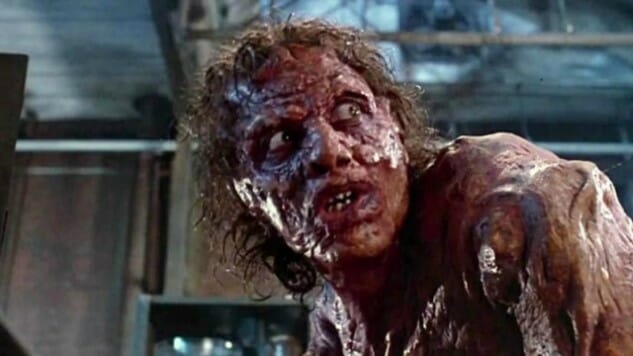The Best Horror Movie of 1986: The Fly

This post is part of Paste’s Century of Terror project, a countdown of the 100 best horror films of the last 100 years, culminating on Halloween. You can see the full list in the master document, which will collect each year’s individual film entry as it is posted.
The Year
Another strong year overall, 1986 continues the mostly “fun”-focused tone of 1980s horror, while also introducing an underbelly of darker psychological horror in the form of several particularly uncompromising serial killer movies. These two notable films, Henry: Portrait of a Serial Killer and Manhunter, certainly raised some eyebrows at the time of their release, and provided the building blocks that would eventually get the genre to crossover smash hits like The Silence of the Lambs and Seven—and not just because Manhunter is the first on-screen appearance of the Hannibal Lecter character, either.
Of the two, it’s really Henry that is hardest to forget or wash away, after watching. This is a dirty, grimy, icky film, notable for the way it sets its story through the point of view of its titular killer, but never even attempts to somehow get the audience on his side. Henry is a monster; one who doesn’t quite seem to understand what drives him, but also makes no effort to fight it. He simply wakes up one morning, dispassionately feeling like maybe he should kill someone, and then goes out and does it. Michael Rooker is superb as the damaged and totally empty Henry, staring into the mirror with nothing at all behind his eyes, able to avoid asking himself any difficult questions. This film’s violence, likewise, is totally unlike the gleeful carnage of the still popular slasher genre—the audience is meant to react to it with disgust and revulsion rather than cheers or titillation, especially in infamous sequences like Henry and Otis’ “home movie.” It was a significantly different approach to horror, in a time when most cinematic serial killers were wearing a mask or spouting off cheesy one-liners as they hacked up teens.
The biggest contender for an alternate #1 film this year is of course James Cameron’s Aliens, one of the genre’s most pitch-perfect sequels, even though it utterly transforms the genre and tone of Ridley Scott’s claustrophobic original. Gone is the slow, atmospheric game of cat and mouse, the fear of a single xenomorph lurking among the visually similar tubing and bulkheads. Cameron correctly concluded in his assessment of the situation that in order to top Alien, he had to raise the stakes (and threat level) with a bevy of the creatures, but that in doing so, the fear generated by any single xenomorph would be sacrificed—also known in the world of tropes as the “inverse ninja law.” Wisely, then, he instead switches gears from outright horror to focus on explosive action and characterization, setting up the returning Ripley alongside a cast of endearing colonial marines, who we sadly have to watch be picked off one by one. Aliens, like Cameron’s own Terminator 2, completes Ripley’s path from fearful starship crewwoman on the run, to hardened badass—the same sort of transformation experienced by Sarah Connor in between the first two films of that series. Few films in cinema crystalize that sort of character growth more epically than Ripley striding out in the power loader: “Get away from her, you bitch!”
There’s still a bevy more honorable mentions of merit, especially in the slasher genre, which is increasingly turning toward gimmickry here in an effort to remain fresh, such as in April Fool’s Day or the amusing killer robots of Chopping Mall. Special credit goes to Friday the 13th Part VI: Jason Lives, which has got to be the best SIXTH installment of any slasher franchise, and a fan favorite to those who love Jason Voorhees, who returns here as a superpowered, undead engine of destruction for the first time. The cracks are beginning to show in the foundation of the slasher genre, but it still has a few more decent years left in it.
-

-

-

-

-

-

-

-

-

-

-

-

-

-

-

-

-

-

-

-

-

-

-

-

-

-

-

-

-

-

-

-

-

-

-

-

-

-

-

-








































